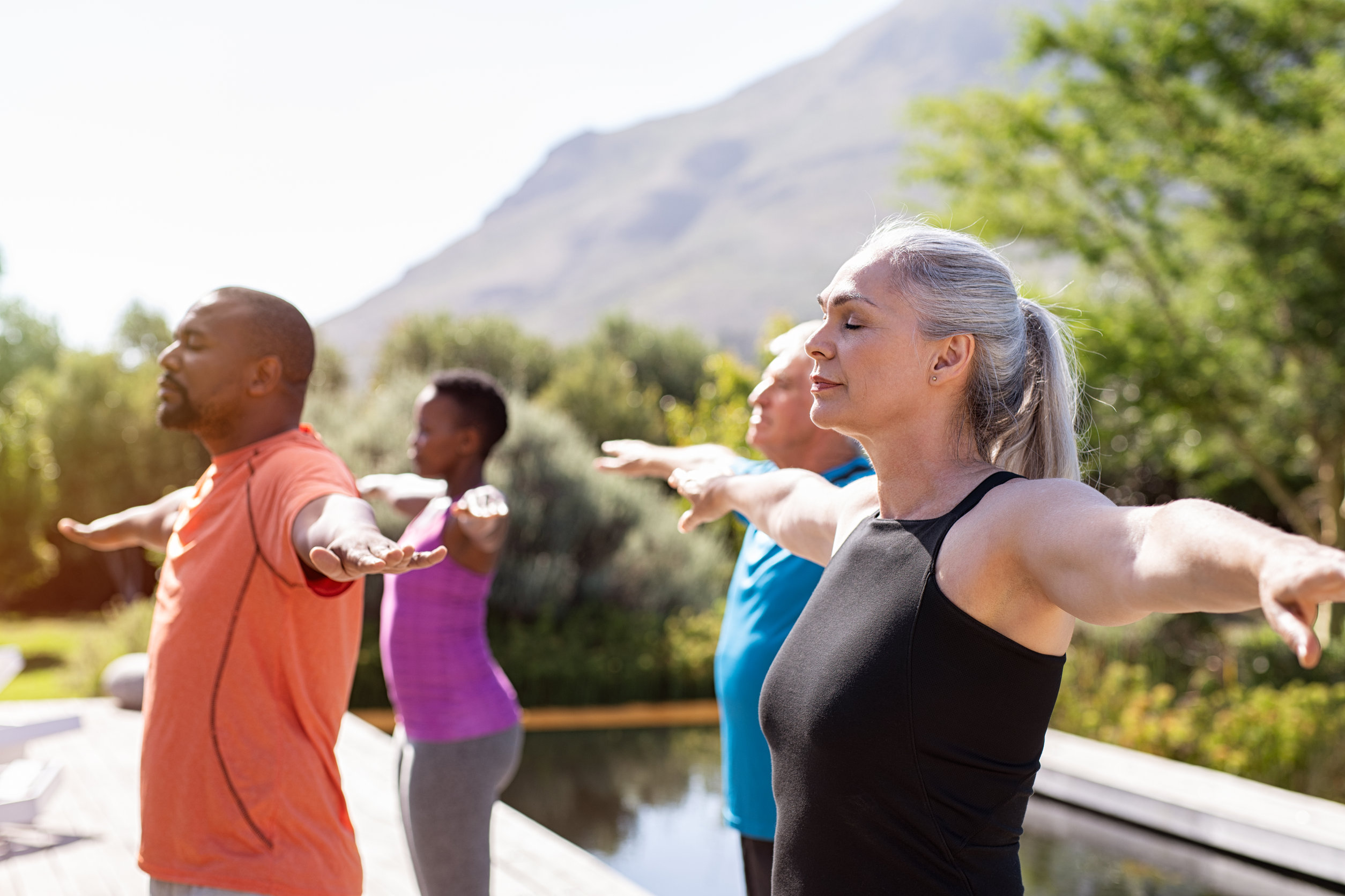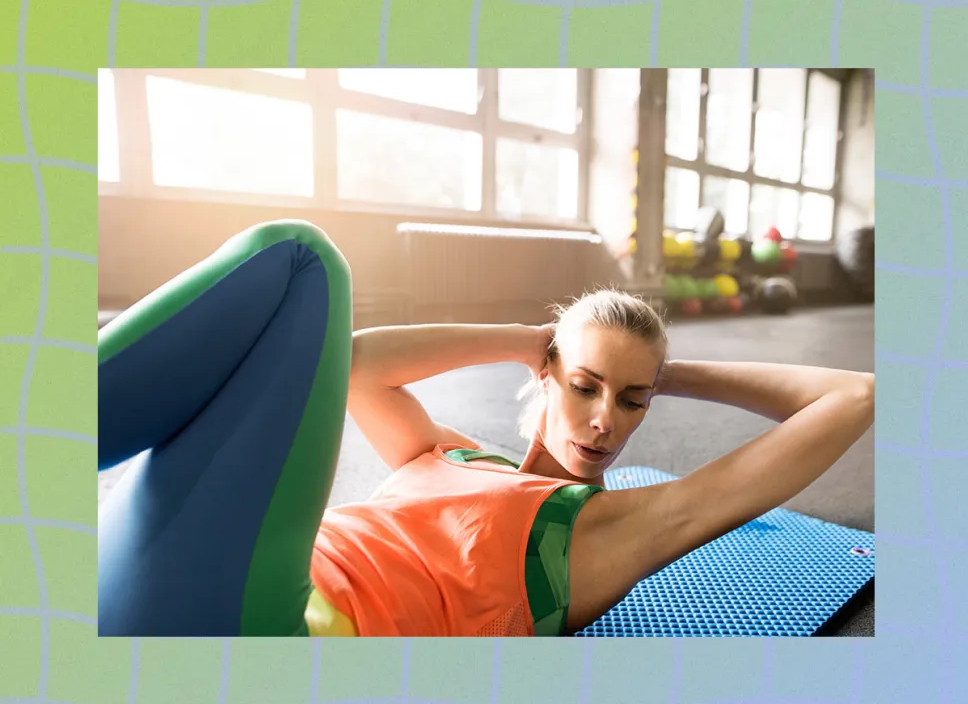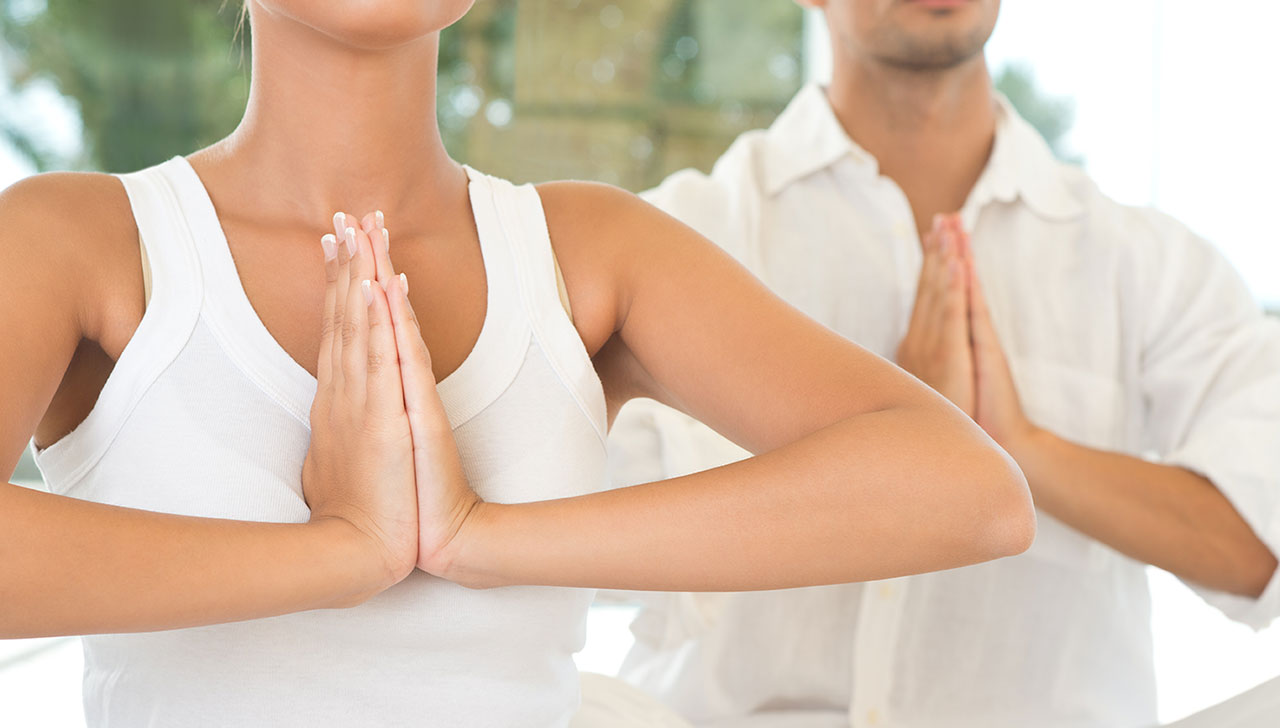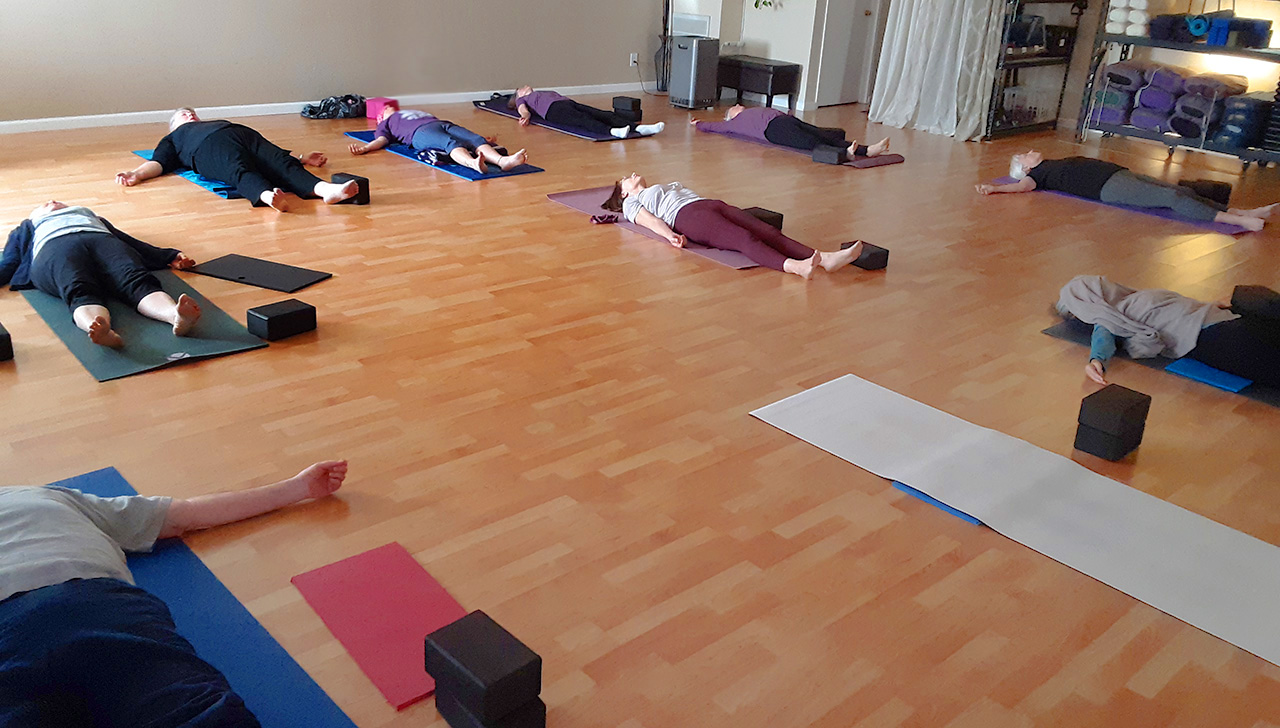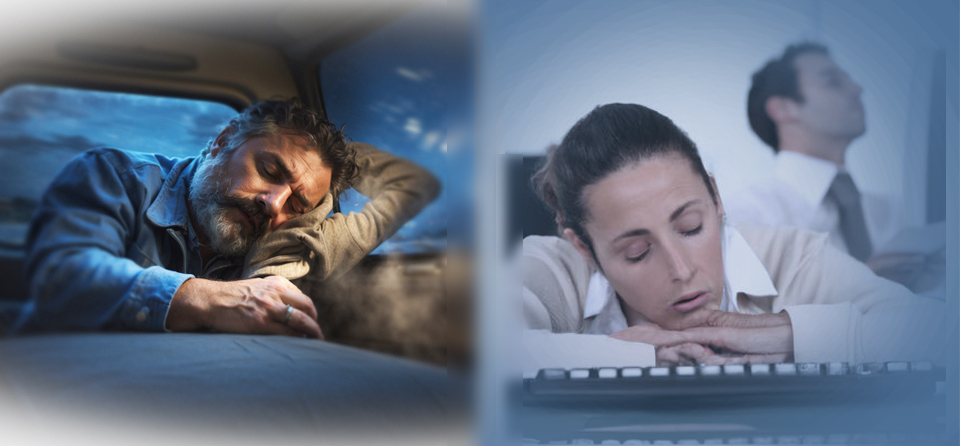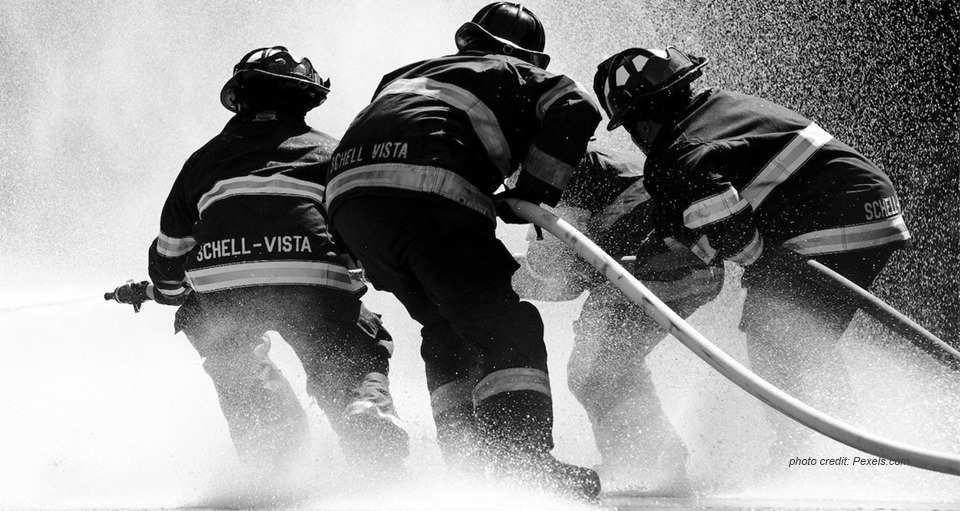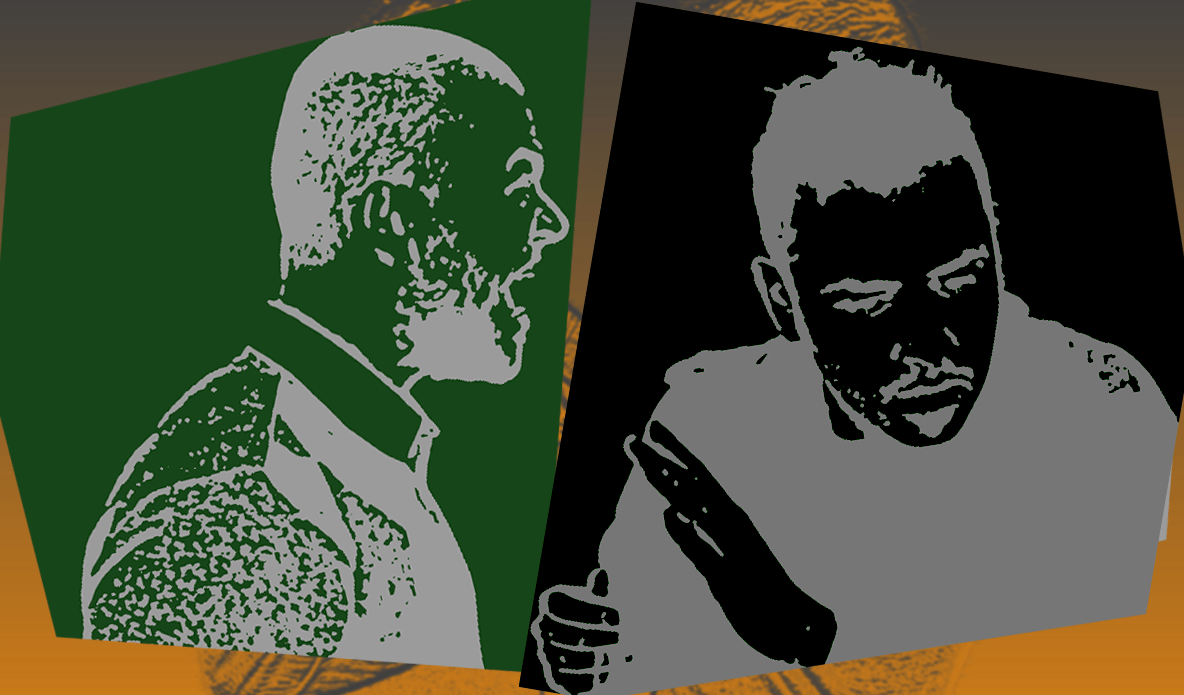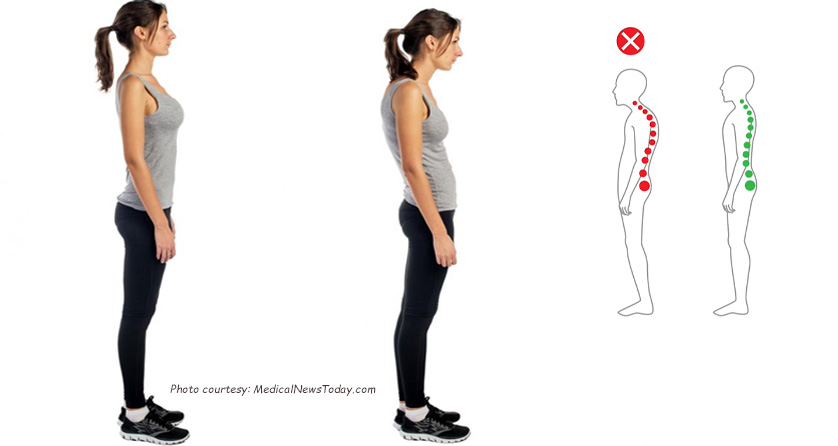STOP! Better body function is not mastering 50 pushups. Instead, stretch to reclaim your body for what YOU care about.
by Gwenn Jones, CPT
April 18, 2022
Is stretching something you say you do, but don’t?
Regular stretching as we age is more vital than you might think. Why? It improves flexibility and mobility, and it boosts your energy like crazy. And the amazing dessert of it all? It allows higher function in your daily life.
Isn’t that what you want?
For your body to answer when you call on it? To move more freely?
Does it frustrate you that you can no longer do what you once did lots of? Let’s improve it starting today. Reclaim your body.
This is your calling!
In the city of 27,000 where I live and work, more than 51% are seniors. I serve many of them. Our local physicians urge their aged 50-75+ patients to get moving, again and again. Largely, I believe, because of too many causeless doctor visits for body aches or stiff muscles.
This overbooks doctors’ schedules where more vital healthcare appointments are needed. Wait lists in our California county are 3 months out. Ridiculous. The doctors’ commands are pretty uniform. “Start some yoga,” “Stretch your body.” “Take a walk.”
It’s not an invitation – it’s more like a summons!
Why are you this way? Frequent causes of stiff muscles
Most of us realize it is the consequence of our lifestyles. However, for official article purposes, we should quickly review the basic causes of muscle challenges, without judgment. Certain conditions or genetics contribute to muscular difficulties. Those aside, joint and muscle immobility, tightness, or atrophy are frequently due to lots of sitting or poor posture. This writing addresses the latter.
Chew well on this next paragraph…
“The body adapts to the movements you most frequently make. The corollary to that is that the body adapts to the movements you don’t make: It adapts by not making those movements anymore,” says Jules Mitchell, yoga instructor and a master’s degree candidate in exercise science at California State University, Long Beach.
Beautifully stated and worth reading twice. So, recurring motion contributes to your current, resultant mobility and musculature. As well, doing almost nothing (physically) gifts you with almost nothing in return. Perfectly logical, but it’s a bitch.
Whatever path you’ve landed on, it’s the resolutions that pose the challenges.
How to take charge to better the function of your body, today
It’s never too late to get better. Get started immediately with friendly movement, maybe around your house. Boring, but a start. Better yet, walk down the block SLOWLY then back home. You’ll be quite proud of yourself. Baby steps here.
In more serious cases involving your joints, it is best to visit your healthcare provider for where to begin a new activity. Be confident you are not too far gone to improve.
Let’s focus on YOU
Why should you stretch to improve your body function?
Why the heck shouldn’t you stretch? Joint range of motion, body flexibility, posture, aches and pains, body functionality, circulation, and joint stabilization all improve. Yes, massively dull words here. But stay awake, because your physical and even mental improvements will be far from dull.
DO SOMETHING AWESOME FOR YOURSELF
A rousing new world opens, a new sun shines, and the outdoors smells exhilarating. You’ll go out more, meet friends, try restaurants, and walk by a lake. You’ll even breathe better as your chest and lungs open up to greet the rich outdoors. Wowsers, that’s delectable.
Let’s get to it. Do you think you stretch? Let’s see.
Is this you? You stand, arms to your sides, flap your arms for 5 seconds, cuss and whine for 6 seconds and voilà, done. Am I right? Most of us think we know how to stretch. The truth is…
In my 25 years of personal fitness training, with 15 years teaching yoga, 99% of folks I meet “know how to stretch.” Within 30 seconds I find that 98% do not.
Whether a casual exerciser, dog-walker, house painter, or sofa slug, let’s find out the when to’s and how to’s for effective stretching for a new YOU.
When should we stretch?
Anytime muscles are warm. So that could be after a shower, a walk, or a workout. (Bypass long stretches before a workout. This is ill-advised.)
Is morning or night better?
Whatever works for you.
Who should stretch?
Anyone desiring easier mobility (hopefully everyone). Especially as we journey to senior-hood. The most popular class at my yoga studio is our Friday Stretch. These folks, in their 50s, 60s, and 70s, eagerly set out to correct or reverse whatever has landed them in the pain and immobility they suffer today. Those that stick with even a gentle stretch regime are just tickled to be moving with less pain. Did I just say, “moving?”
Who are these folks? Mostly women, like you, who raised families and worked jobs during the 80s and 90s. No time for walking, biking, dancing, or swimming. Fairly, no time for self-care–for double decades.
Most of my current and incoming students are from this population. First-timers unveil a bit of frustration here–in a giggly way. That’s my gracious way of saying they groan!
- First, these new students are stunned at their struggle just to rise, bend forward, or lower themselves to the floor. They lack the range of motion or strength to enter into the gentlest positions. This is common. Your coach must assure you that you are NOT ALONE and “you’ll get there.” You will.
- Second, the bigger shock is our newbies marvel at how seamlessly our progressive seniors move, stand, and lift their arms. They were once immobile too. Again, it’s important to convey that “you will get there with practice.” And soon you’ll be spitting out a downward-facing dog.
Encouragement is critical so these women (and men) remain devoted to their goals and meet them.
I consider these thirsty recruits the “body reclaimers.” First and foremost, they show up. What a colossal start. So what’s next?
What do you need to crush this?
Self-patience, consistency, and support are essential for any improved fitness. Every person in our class feels motivated and supported by every other person in our class. Sounds sappy but this canopy of comfort covers us all like melting butter. Laughter flows often (sometimes due to my no-shame sarcasm.) And, if we roll sideways, we don’t apologize, we chuckle and redo.
For non-group, I encourage home stretching practice. We often must steal time here. Don’t wait for it – make it happen.
Whether outdoors, at home, or in class, you will finish your stretch session feeling massively enriched. Mobility improves each week. The results are a rush. You want more. You’ll become accountable. The more you practice, the quicker your results. Even 10 minutes of stretching a day will improve your daily body function.
Each breakthrough becomes a spectacular occurrence!
Yes, you have 10 minutes. Part of the thrill is your own body’s capability. What you become capable of brings back memories and spurs new ideas. Each new movement becomes a spectacular occurrence.
I love when I hear, “Wow, I couldn’t sit like this 6 months ago.”
Will stretching make your muscles longer?
Technically, no. Stretching does not elongate muscles permanently. Proper stretch practice trains our nervous system to gradually handle deeper muscle extension without firing pain. I term this as pliability. Proper stretching does not lengthen muscles.
To clarify, muscular pliability does not mean soft and gushy. It refers to the ability to move through a full range of motion and adapt to it with relative ease. Eventually, our nervous system becomes more tolerant of stretch movement. Our range of motion refers to more than the joint itself. Ligaments, tendons, and muscles act in unison. Make sense?
Stretching doesn’t make muscles permanently longer, experts agree. Instead, it may be that exercises such as reaching for your toes train the nervous system to tolerate a greater degree of muscle extension without firing off pain signals. Noted here in Does Stretching Increase Flexibility, https://www.livescience.com/48744-how-does-stretching-work.ht
What kind of stretching should you do to improve body function?
We’re getting a little more technical here. Hopefully, it’s not too techie for you.
For basic informational purposes, here are the most common stretch styles. You should review these since a stretch program is not a one-style-fits-all. And, as always, speak to a professional for guidance.
Stretching Types (simpler stretch breakdown on this page):
- Active Stretch (static)
- Passive Stretch (static)
- Dynamic Stretch
- Yoga (asana)
- Ballistic Stretch
- Proprioceptive Neuromuscular Facilitation (PNF)
- Myofascial Release
We won’t review all of the above since our topic addresses beginners.
What is a static stretch?
A proper (static) stretch is: With warmed-up muscles, hold the body part in a stationary position to stabilize the muscle safely at a slightly tense length to achieve a greater range of motion. That was a mouthful.
Joints should be soft and unlocked. A standard stretch duration is 15-30 seconds. (In time, the best results are achieved with a duration of 30-60 seconds.)
The longer you hold a stretch, the more blood and heat develop in that muscle. A good thing. Notice I wrote hold the body part, as opposed to pull or push tighter and further with force. We don’t do that. Pulling defeats your stretch (described in Stretch Reflex below). I correct folks on this constantly. Remember? Those 98% who “know how to stretch.”
TIP #1:
Never bounce or stretch to the point of pain. Improving your flexibility is slow and progressive. Your stretch class or home practice should never be brutal or cause you anxiety. So, no screaming, please. Most who stretch or practice gentle yoga, for example, consider it dessert. I see it every day.
What is fascia / myofascial?
Our fascia is a flexible connective tissue. It works like a web that wraps and holds all of our bones, muscles, nerve fibers, and other internal organs. Myofascia (myo = muscle; fascia = band or tissue).
Review this Chart for your assistance: General Styles of Stretching which designates:
- The style of stretch
- The description of the movement
- What ability level the stretch style targets
Is static stretch best for flexibility and better body function?
Yes, usually. Static stretching can be “active” or “passive.” One is with external support, one is without. I’ll clarify that.
Active stretching (without external support): Most common, is performed with self-control and physical effort. Specifically, a stretch is held by utilizing our strength and WITHOUT outside support. This means you and your body alone. No props, no assistance.
Often, in the active stretch, one muscle group contracts while the opposing muscle group relaxes during the hold. In other words, one muscle group helps stretch the other.
Proper examples of active stretches are:
- Lying supine (face up) lifting one leg toward the ceiling and feeling a hamstrings stretch
- Standing or lying prone (face down) bringing one foot to the butt by knee flexion for a quadriceps stretch
- Standing, arms lifted overhead bending to the side (see image below; Side Bend)
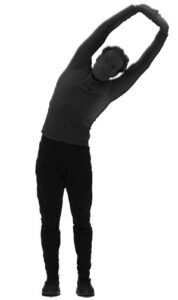
1. Side bend (active stretch)
So, in the Side Bend image, the model is using his stabilizing muscles to perform the stretch without assistance. No wall, no strap or band, no prop.
Passive stretching i.e., static stretching WITH external support: Passive stretching technique means you contribute no physical effort to the target muscle group. The muscle is stretched in a relaxed state utilizing props to assist you. The props are your external support.
Examples of passive stretches are:
- Standing forward bend (hands-free) which uses gravity to pull you down
- Lying supine (face up) wrapping the foot with a strap or towel to stretch the hamstrings (see image below)
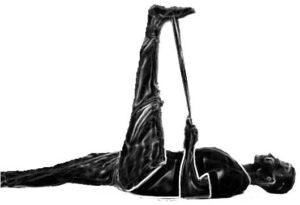
2. Hamstrings stretch (passive stretch)
Another passive stretch example would utilize a partner to stretch you while your body is relaxed. Passive stretches are fabulous post-workout because your muscles are warm and well-prepared. This passive partner technique is commonly used in physical therapy. So, passive stretching is accomplished with either a prop, a device, or a partner. One of those is your “assistant.”
TIP #2:
Restorative yoga is a mild example of a passive stretch since props are used to support the body. Restorative-style yoga stretches are calming and usually held for 5 minutes each. Restorative often involves more opening of the body rather than muscle work. But, it’s super fine dessert as seen in the image below.
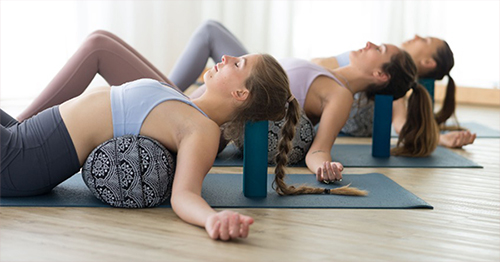
3. Reclined Bridge pose (above). A restorative posture (passive stretch) that opens the chest, ribs, and anterior deltoids (front shoulders) – using support props
Stretching with muscle atrophy
When beginning an exercise flexibility practice, studies have shown active stretching can be more beneficial. Why? Because we are utilizing and strengthening (by default) one muscle group while supporting or holding another muscle group in place for the stretch. Consider an active stretch to be a smidgen of multi-tasking for your musculature.
Whereas, in the passive stretch technique our muscles (or our bodies) are relaxed. This makes perfect sense. Without a doubt, a physical therapist or professional fitness trainer should be consulted to start you on a safe path.
What is muscle atrophy?
- The term muscle atrophy refers to the loss of muscle tissue. Atrophied muscles appear smaller than normal. Lack of physical activity due to an injury or illness, poor nutrition, genetics, and certain medical conditions can all contribute to muscle atrophy. (See What to know about muscle atrophy, https://www.medicalnewstoday.com/articles/325316)
- Muscle atrophy is a term used to describe the loss of muscle. Atrophy may occur from injury, starvation, disease, bed rest, nerve damage, and other health-related issues. Atrophy is especially common in older adults, and is called sarcopenia. (See Understanding muscle atrophy: Use it or lost it, https://blog.nasm.org/muscle-atrophy). (
How do you know you stretch correctly? Use this rule of thumb.
The correct general principle is: When the (warmed) muscle is elongated in a slow, smooth, controlled manner, it reads no threat and a stretch reflex* is not activated. As a result, you can extend the muscle slightly further than you are normally able. The goal of a good stretch is to get the muscle to relax (or soften) in this lengthened position. Done correctly, you feel the muscle release in about 8-10 seconds.
Consistent breathing is a must in stretching. Closing your eyes once you enter your hold, along with blissful exhales, helps relax the muscle group and maintain your mental focus. See more guidance further on. See my sumptuous stretch recipe for you here.
*What is Stretch Reflex
This occurs when a muscle is stretched too far or too fast causing the muscle to contract to avoid injury to itself. “Muscle spindles” send signals to the brain, and in turn back to the muscle to contract (or shorten) to protect from the threat of injury. The stretch reflex should always be avoided. This is a good way to achieve No results.
It is not difficult for a qualified coach/instructor to decipher if one is stretching inappropriately. Quite often newcomers believe that the pain is the stretch point, “the touchdown.” Wrong. I find this especially common with ex-athletes. Pain and tension differ. Never stretch the muscle beyond the first feeling of tension.
TIP #3:
You don’t need to WOW anybody! Did you read that ex-athletes?
Stretch specificity. Work on what YOU care about and start here
Typically for those with little physical activity, particularly post-pandemic, my first recommendation is to get walking. TODAY. Slow is fine, just get moving. Every new student I teach performs 80% easier when they can move their legs around to enter and exit a position. Makes sense, right? So start today.
TIP #3 ½:
Fun stuff. Socializing your walk is great interaction and shortens time. Invite a neighbor or friend.
Another tip… a phone app. I use a free phone app that counts my steps. It applauds and tosses confetti if I meet my goal. Hysterical. (On an Android it’s the “Pedometer – Step Counter.”)
Another tip… calendar your walks, like maybe before or after breakfast or dinner – or both.
What do you miss in your life?
What do YOU want to do in your life? Reclaim it
Dovetailing on that, perhaps you golfed or played pickleball, but now you feel incapable. Focus on tailoring some gentle dynamic movements to get back in the saddle. Include some trunk twists. Direct these moves to get you back to YOUR life priorities – not your neighbor’s, not your coach’s, not your social media friends. Seriously, what do you miss in your life? Reclaim it.
You might merely want more ease in stepping out of the car, or getting out of a chair, right? There’s help everywhere. (Videos, YouTube, personal trainers, physical therapists, etc.) Remember you don’t need to Wow anyone. It’s all about YOU here.
Lack of initiative?
Throughout my fitness training career, the two reasons people claim they don’t pursue personal fitness improvement are 1) Admitted laziness and, 2) the output of money.
My response is how badly do you want a better quality of life? Other than that, I don’t address this.
How often should you stretch?
Stretching is part of physical health, therefore some form of stretch is advisable 2-3 times per week – more if you wish. And, walking is recommended daily for seniors with a target of 20-30 minutes (start gently). Walks help us move better, forever.
Find more guidance and input on seniors and walking:
When NOT to stretch
- After injury. Discouraging as injuries are, stretching should be paused until improvement begins
- Post-surgery. Only begin with a recommendation from your healthcare provider or physical therapist
- When you are cold
- Those ‘overly flexible’ could indicate joint instability issues. Consult a physical therapist
Here’s a little assistance. My icing on the cake for you, link here to my sumptuous stretch recipe for you.
So finally
You made it all the way – almost. We’ve examined the fundamentals of how to improve your body function; tailoring your stretch method for YOUR desires; muscles’ reaction to proper and improper stretch practices; and proper warm-up.
Utilize this advice and stretch smart. Pause for a slice and review where YOU lack mobility. What activity do you crave or miss? Prioritize it.
Customize your stretch routine to earmark your goals. Most personal trainers can set you up if needed. Stretch 2-3 times per week, ideally after a walk or dynamic warm-up. START GENTLY. Tread water, no deep diving.
A true “high” will overtake you with a fabulous surge of energy, clarity, and confidence. The long-term rewards just keep coming. Some of my seniors have practiced with me for over 12 years. Many have arthritic, back, and joint issues. We work through them and modify moves to stay within a doable practice. In turn, they can play pickleball, walk, hike, kayak, and RV. They walk with pride; they play with gratitude. They’ve become mobility monsters!
Should you make it to a stretch or gentle yoga class you will find a group camaraderie like no other. Laughter, kindness, and patience saturate the room. Reclaim your body, get your life back, and have a blast!
Remember there is a new sun shining soon.
Need a hand? Contact me here.

Article by:
Gwenn Jones, CPT — Content writer in Wellness-Lifestyle-Fitness, Gwenn is a 25-year ACE-certified personal fitness trainer, yoga studio owner, instructor and fitness consultant. Grateful to be a native Californian where happily home-based.
Zoe Weiner, How to Increase Flexibility Throughout Your Entire Body, According to Pro Stretchers. Wellandgood.com, February 7, 2020, https://www.wellandgood.com/how-to-increase-flexibility/
Staff, The importance of stretching, Health.harvard.edu, September 25, 2019, https://www.health.harvard.edu/staying-healthy/the-importance-of-stretching
Tia Ghose, Does Stretching Increase Flexibility? Livescience.com, November 13, 2014, https://www.livescience.com/48744-how-does-stretching-work.html
Excerpt by Jules Mitchell, julesmitchell.com, https://www.julesmitchell.com/
Jamie Eske, Medically reviewed by William Morrison, M.D., What to know about muscle atrophy. Medicalnewstoday.com, May 30, 2019, https://www.medicalnewstoday.com/articles/325316
Jerod Langness, Understanding Muscle Atrophy: Use It or Lose It, blog.nasm.org, July 24, 2018, https://blog.nasm.org/muscle-atrophy/

